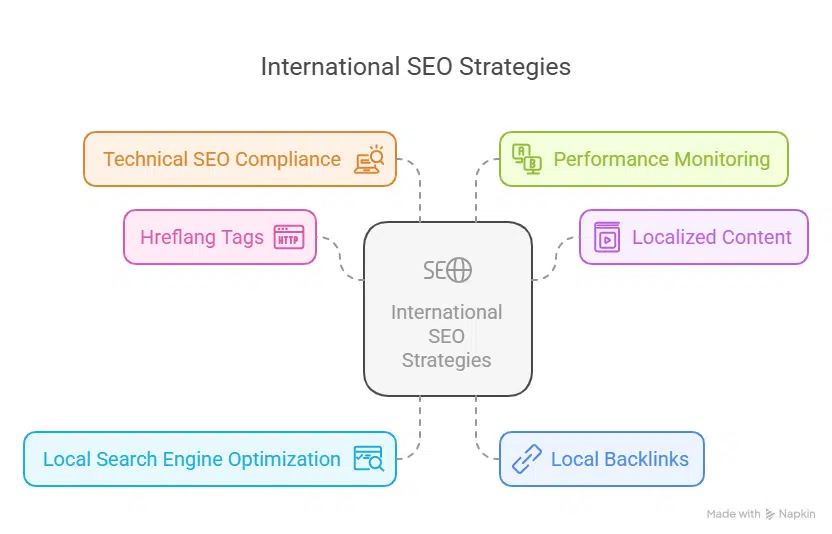
08 Apr Best International SEO Services- SEO Business Company
Expanding your business into best international SEO markets is a significant endeavor that requires a strategic approach to Search Engine Optimization (SEO). best International SEO involves tailoring your website to effectively reach and engage audiences across different countries and languages. This comprehensive guide will explore the essential components of international SEO, providing you with the knowledge to enhance your global online presence.
Table of Contents
Understanding best International SEO Services
Best International SEO is the process of optimizing your website so that search engines can identify the countries and languages you are targeting. This ensures that users in different regions receive content that is relevant to their cultural and linguistic context. Effective best international SEO helps in improving search rankings, increasing visibility, and driving organic traffic from various global markets.

Key Strategies for Effective best International SEO Services
1. Conduct Thorough Market Research
Before expanding internationally, it’s crucial to understand which markets offer the most potential for your business. Analyze your current website traffic to identify countries with significant visitor numbers. Utilize tools like Google Analytics to assess user behavior and preferences in these regions. Additionally, research local competitors to understand market dynamics and identify opportunities for differentiation.lokalise.com
2. Perform Multilingual Keyword Research
Keyword research should be conducted separately for each target market, considering linguistic and cultural differences. Direct translations of keywords may not capture local search behaviors accurately. Use tools like Google Keyword Planner to identify relevant keywords in the local language, ensuring they align with the search habits of your target audience.
3. Choose the Appropriate URL Structure
Selecting the right URL structure is vital for signaling to search engines and users the geographic and linguistic targeting of your site. Common structures include:
Country Code Top-Level Domains (ccTLDs): e.g., example.fr for France. This approach clearly indicates country targeting but requires separate domain management for each region.
- Subdomains: e.g., fr.example.com. This method allows for easier management under a single domain but may not convey as strong a geographic signal as ccTLDs.
- Subdirectories: e.g., example.com/fr/. This structure is straightforward to implement and benefits from the authority of the main domain but may be less clear in geographic targeting.
4. Implement Hreflang Tags
Hreflang tags are HTML attributes that inform search engines about the language and regional targeting of a webpage. They help prevent duplicate content issues and ensure users are directed to the most appropriate version of your site. Proper implementation of hreflang tags is essential for effective international SEO.
5. Develop Culturally Relevant Content
Localization involves more than translating text; it requires adapting content to reflect local customs, values, and preferences. This includes using appropriate imagery, idioms, and cultural references. Collaborate with native speakers or local experts to create content that resonates with the target audience.WordStream
6. Optimize for Local Search Engines
While Google is dominant in many regions, other search engines like Baidu in China or Yandex in Russia hold significant market shares. Understand the algorithms and ranking factors of these local search engines to optimize your site accordingly.
7. Build Local Backlinks
Acquiring backlinks from reputable local websites enhances your site’s authority and relevance in the target market. Engage with local influencers, bloggers, and industry publications to build a robust backlink profile.
8. Ensure Technical SEO Compliance
Technical aspects such as site speed, mobile-friendliness, and secure connections (HTTPS) are crucial for user experience and search rankings. Ensure your website meets these technical requirements across all regional versions.
9. Monitor Performance and Adapt Strategies
Regularly analyze key performance indicators (KPIs) like organic traffic, bounce rates, and conversion rates for each market. Use this data to refine your strategies and address any issues promptly.

FAQs on International SEO Services
Q1: What is the difference between international SEO and local SEO?
A1:
Best International SEO and local SEO serve different business objectives and target audiences:
- Local SEO is focused on enhancing your online presence within a specific geographic location. For example, if you’re a bakery in Chicago, local SEO tactics—like Google Business Profile optimization, local citations, and local keywords—help you appear in search results when nearby customers search for “bakery near me” or “best cakes in Chicago.”
- Best International SEO, in contrast, involves optimizing your website so it appears in search results across different countries and languages. It’s a strategic approach designed for businesses targeting customers in multiple countries. This involves tasks such as multilingual content, region-specific keyword research, international link-building, and implementing hreflang tags to indicate language and regional targeting.
Bottom line: Local SEO is about dominating your city or neighborhood. Best International SEO is about expanding your visibility and customer base globally.
Q2: How important is it to have a local domain for each target country?
A2:
Choosing the right domain structure is critical when entering international markets. There are three main options:
- Country Code Top-Level Domains (ccTLDs) – e.g., example.fr for France or example.de for Germany. These signal to both users and search engines that your site is meant specifically for a country, building strong local trust and improving rankings in that region.
- Subdomains – e.g., fr.example.com or de.example.com. Easier to manage under one domain but less impactful in building local SEO trust compared to ccTLDs.
- Subdirectories – e.g., example.com/fr/ or example.com/de/. Cost-effective and easy to manage while still allowing for content segmentation by language/region.
While ccTLDs can offer stronger regional signals, they also require more resources—separate hosting, maintenance, and possibly different SEO strategies. For businesses with limited budgets or centralized control, subdomains or subdirectories can work well if optimized correctly.
Q3: Can I use automated translation tools for creating multilingual content?
A3:
Using tools like Google Translate or AI-based auto-translators may seem convenient, but they often fall short in quality. Here’s why:
- Lack of contextual accuracy – Automated tools struggle with idioms, slang, and regional expressions.
- Cultural disconnect – Automated translation doesn’t account for cultural differences, tone, or consumer behavior.
- SEO performance – Poor translations can hurt credibility, increase bounce rates, and lower rankings.
Instead, it’s best to work with native-speaking translators or localization experts who understand not only the language but the cultural nuances of your target audience. This approach ensures content is engaging, persuasive, and optimized for local search engines.
Q4: How do hreflang tags impact SEO?
A4:
Hreflang tags are HTML attributes that tell search engines which language and regional version of a webpage should be shown to users based on their geographic location and language preferences. For example:
Why are hreflang tags important?
- Prevent duplicate content issues when similar content exists in multiple languages or regions.
- Help ensure the right version of a page is shown to the right audience, improving user experience.
- Support better indexing and ranking in regional SERPs.
Failure to use hreflang properly can lead to confusion for both users and search engines, impacting visibility and traffic.
Q5: What are common challenges in international SEO?
A5:
Expanding globally with SEO introduces several complexities. Key challenges include:
- Website Management – Running multiple language or country versions requires structured planning, separate content strategies, and ongoing updates.
- Translation Quality – Ensuring linguistic and cultural accuracy in every region is resource-intensive but critical for user engagement and trust.
- Cultural Relevance – Keywords, visuals, tone, and even product preferences may vary across markets. What works in the U.S. might not appeal to users in Japan or Brazil.
- Search Engine Variations – Google dominates many markets, but in regions like China (Baidu), Russia (Yandex), or South Korea (Naver), local search engines have different ranking factors and algorithms.
- Backlink Acquisition – Building links from local, reputable sources in each market is essential but often difficult without a local network.
A successful international SEO strategy requires a deep understanding of both technical SEO and the cultural landscape of each target market.
Conclusion
Best International SEO isn’t just about translating content—it’s about localization, cultural adaptation, technical precision, and market understanding. By crafting tailored content for each region, implementing proper domain structures, and maintaining technical best practices like hreflang, businesses can unlock global visibility, drive targeted traffic, and maximize conversion rates in every market they serve.
